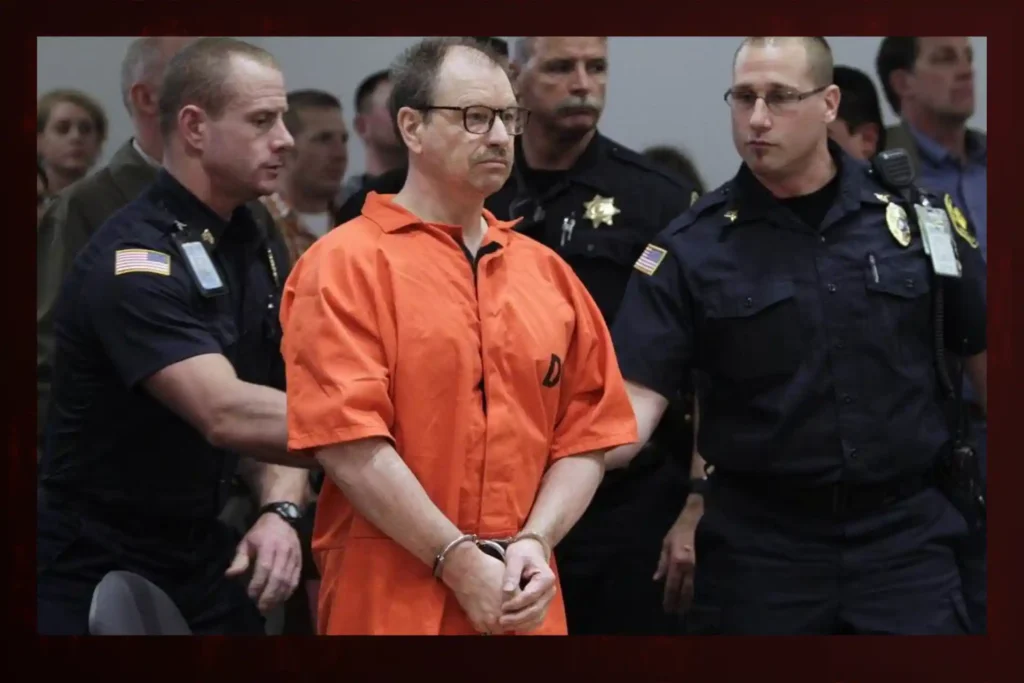Gary Ridgway, better known as The Green River Killer, is one of the most notorious and prolific serial killers in American history. Over two decades, Ridgway brutally murdered dozens of women, earning a reputation that still haunts the Pacific Northwest. His chilling crimes and long periods of evasion left a legacy of fear and questions that continue to resonate today.
Table of Contents
The Man Behind the Murders: Who Was Gary Ridgway?
Gary Ridgway lived a seemingly normal life on the surface. Born in 1949, Gary Ridgway’s family life was troubled, as he experienced a difficult childhood that contributed to his later actions as a serial killer. Gary Leon Ridgway struggled academically and exhibited disturbing behavior from an early age, showing signs of aggression and cruelty toward animals. Despite these early red flags, Ridgway managed to blend into society, holding a steady job as a truck painter and marrying multiple times.
Ridgway’s public persona was that of a quiet, unassuming man, often attending church and engaging with his community. But behind this mask, he harbored dark urges that drove him to commit one of the most gruesome killing sprees in American history. Ridgway targeted vulnerable women, primarily runaways and sex workers, whom he lured with the promise of money or help, only to end their lives in cold blood. His ability to live such a double life for years made him one of the most elusive and prolific serial killers the world has ever seen.

The Green River Murders: A Twisted Tale of Terror
The Green River Murders began in the early 1980s, casting a dark shadow over the Seattle area. The killer’s methods were chilling. The killer’s preference for dumping his victims in wooded areas or along riverbanks only added to the twisted, nightmarish nature of his crimes.
With each new body, the terror grew, and the media quickly dubbed the perpetrator The Green River Killer. Investigators were baffled. Despite their best efforts, the killer continued his deadly spree for years, evading capture and leaving law enforcement in a desperate race to stop him.
The Green River Murders represent one of the most twisted and terrifying chapters in American criminal history, a haunting reminder of the evil that lurks behind a seemingly ordinary facade.
Inside the Mind of a Killer: How Ridgway Chose His Victims
Ridgway’s motivations were complex, rooted in a mixture of sexual desire, control, and a desire to exert power over his victims. This ability to deceive played a crucial role in his modus operandi, as he presented himself as a benign figure, contrasting starkly with the horrific acts he would commit.
Psychological experts believe that Ridgway’s choice of victims was influenced by his troubled upbringing and his need to dominate. His brutal methods of murder—strangulation, in particular—allowed him to exert ultimate control, fulfilling a twisted fantasy that satisfied his compulsions. The infamous serial killer in Seattle, Washington, was Gary Ridgway, who confessed to murdering over 70 women in the region during the 1980s and 1990s. His chilling choices highlight not only the vulnerability of his victims but also the darkness that can exist beneath a seemingly ordinary exterior. The legacy of the Green River Killer serves as a haunting reminder of the need for awareness and protection of society’s most vulnerable individuals.
Ridgway’s psychology was influenced by a deep need for control and power over his victims. For a deeper dive into what drives serial killers, explore our article on the mind of a serial killer.
How Did Gary Ridgway Stay Hidden for So Long?
Gary Ridgway, the Green River Killer, managed to elude capture for nearly two decades, a chilling feat that has baffled both law enforcement and criminologists alike. Several factors contributed to his ability to remain undetected for so long, creating a perfect storm for one of America’s most notorious serial killers.
1. Targeting Vulnerable Victims
Ridgway primarily preyed on vulnerable women, including sex workers and runaways. These individuals often had unstable lifestyles, making it difficult for authorities to track their disappearances effectively. Many were overlooked by society, leading to a lack of urgency in investigations when they went missing.
2. Deceptive Persona
On the surface, Ridgway appeared to be an ordinary, law-abiding citizen. He was a married man, held a steady job as a truck painter, and was active in his community. This unassuming exterior allowed him to blend in seamlessly and avoid suspicion while he carried out his horrific crimes.
3. Evasion Tactics
Ridgway was meticulous in his methods. He would often choose remote locations to dump the bodies of his victims, making them difficult to find. By disposing of the remains in wooded areas near the Green River, he exploited the terrain to his advantage, allowing him to evade law enforcement efforts.
4. Long Span of Activity
Ridgway’s killings spanned from 1982 to 2001, a time during which he refined his techniques and avoided capture. His confidence grew over the years, which likely emboldened him to continue his killing spree without fear of being caught.
Cracking the Case: How DNA Finally Brought Ridgway Down
The capture of Gary Leon Ridgway, the infamous Green River Killer, is a powerful testament to the evolution of forensic science, particularly the use of DNA evidence. However, advances in DNA technology ultimately led to his downfall. The extensive search for Ridgway led to the establishment of specialized task forces and a greater emphasis on using DNA evidence to solve cold cases.
Detectives collected DNA samples from Ridgway after obtaining a court order. They compared these samples with the evidence collected from the victims, leading to a match that confirmed Ridgway’s involvement in the murders.
DNA played a crucial role in capturing Ridgway, much like it did with other infamous killers. For example, Richard Ramirez was also eventually caught thanks to forensic breakthroughs.
The Investigation’s Challenges: How Law Enforcement Faced the Green River Killer

The capture of the Green River Killer in 2001 brought relief to the families of his victims and marked a significant turning point in the investigation. In the early 1980s, when the Green River Murders first came to light, investigators relied heavily on traditional methods such as witness statements, interviews, and profiling. As police departments learned from their experiences during the investigation, their strategies evolved, shaping future criminal investigations.
Initial Evidence Collection
Gary L. Ridgway, also known as the Green River Killer, was responsible for the deaths of many women in Washington during the 1980s and 1990s. Police collected numerous samples from crime scenes, including hair and bodily fluids. However, the forensic technology available at the time was limited. The samples remained untested or yielded inconclusive results, leaving investigators with little to go on.
Arresting Fear: How Law Enforcement Brought Ridgway to Justice
In November 2001, Gary Leon Ridgway was arrested and charged with the murders of 49 women, a number that would later grow as he confessed to more killings. His DNA was found at multiple crime scenes, linking him definitively to the Green River murders. The breakthrough not only marked the end of a long and harrowing investigation but also showcased the potential of forensic science to bring criminals to justice.

The Impact of the Green River Case
Ridgway’s arrest underscored the importance of DNA evidence in criminal investigations, leading to a greater emphasis on incorporating modern forensic techniques in unsolved cases. The Green River case serves as a model for law enforcement agencies across the country, demonstrating how advancements in science can help solve even the most challenging cases.
The Green River Killer’s case echoes the national shock of other high-profile serial killers, such as Ted Bundy, whose crimes also left a lasting cultural impact.
Cultural Impact and Media Sensation
The media’s coverage of the Green River Killer captivated the nation and brought the story to a global audience. Documentaries, books, and television shows explored the horrifying reality of Ridgway’s crimes, further embedding the narrative into American cultural memory. The story of the Green River Killer became a cautionary tale about the dangers lurking in society, a reminder of the fragility of safety.
Ridgway was one of several notorious serial killers active in the 1980s. If you’re interested in understanding the chilling rise of serial murder during that decade, our article on serial killers in the 1980s offers more insight.
Conclusion
The Green River Killer is a chilling reminder of how dark human nature can be. Responsible for the deaths of over 70 women, Ridgway’s actions created fear in communities across Washington and raised important questions about the safety of vulnerable individuals. His capture in 2001, thanks to advances in DNA technology, highlighted the crucial role of forensic science in solving crimes and brought an end to years of terror. As we remember the victims of Ridgway’s crimes, it’s essential to advocate for those who are at risk and work toward a future where such tragedies do not occur again. By reflecting on this dark chapter in history, we can honor the lives lost and strive for a safer world.
Explore the Chilling Case of Ben Doberman Serial Killer.
FAQs
Who was the Green River Killer?
The Green River Killer is the nickname given to Gary Ridgway, an American serial killer who confessed to murdering over 70 women in Washington during the 1980s and 1990s. He earned this name because many of his victims’ bodies were found near the Green River. Ridgway was arrested in 2001 and is known for his chilling methods and the impact his crimes had on the community.
Is the Green River Killer still alive?
Yes, Gary Ridgway, the Green River Killer, is still alive. He is currently serving a life sentence without the possibility of parole at the Washington State Penitentiary, where he was incarcerated following his arrest in 2001 and subsequent conviction for multiple murders.
How many people did Ridgway kill?
Gary Ridgway confessed to murdering over 70 women, but he was officially charged with 49 counts of murder. His killings predominantly occurred in Washington during the 1980s and 1990s, making him one of the most notorious serial killers in American history.
What impact did Gary Ridgway have on law enforcement?
Ridgway’s case highlighted the importance of DNA technology in criminal investigations, leading to changes in how law enforcement agencies approach similar cases and underscoring the need for improved victim advocacy.
What lessons can be learned from the Green River Killer case?
The Green River case teaches us the importance of vigilance regarding vulnerable populations, the need for advancements in forensic science, and the value of community support in preventing future tragedies.